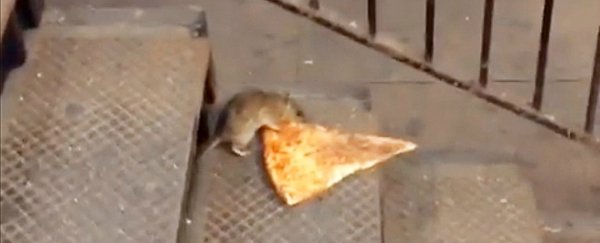Welcome to the age of the urban rat. There are about 2 million New York City rats, a 2014 estimate suggested, which would mean the rodents in New York outnumber the humans in Philadelphia. Do not discount the power of gnawing teeth in aggregate — Cornell University scientists once calculated rats cause $19 billion in damage annually.
Rats and other rodents directly transmit 11 diseases, according to the Centers for Disease Control and Prevention, and they help spread a dozen more.
"It seems to be the urban rat populations are becoming worse than they were," according to Jason Munshi-South, a biologist at Fordham University and the co-author of a new study on city rat populations, published Tuesday in the Proceedings of the Royal Society B. Climate change pushes the thermometer in the rat's favor, he said. So does a renewed interest in urban living. More city-dwellers means more food, more shelter and more resources for rats.
Because of this increased rodent presence — and new biological tools — scientists have recently begun to address rat populations more scientifically, Munshi-South said.
Rats have lived within our shadows for centuries. Norway rats, Rattus norvegicus, crossed the Atlantic aboard European ships in the 1700s.
(The name Norway rats is deceptive, as the rodents originally came from northern China or Mongolia.) If requests for pest control are any indication, rats are out in unusual numbers. Washington's 311 line fielded more than 3,000 rat complaints in fiscal 2016, a four-year high, The Post reported in September. (Headline writers have had their pick of the end-times puns — the coming ratpocalypse, a ratastrophe or Rat-narok.)
In the new report, the biologist and his colleagues mapped the genetics of rats in four cities in the New World: New Orleans, New York, Vancouver and the Brazilian city of Salvador.
The researchers captured at least 150 rats in each city, snipped off a bit of tissue and probed the samples for 15,000 genetic markers. By tracing subtle differences in mutations among rat populations, the scientists identified where different rat families had clustered.
The resolution of the study "is so high it can add landscape features," said Michael H. Kohn, an evolutionary biologist at Rice University in Texas who was not affiliated with the new study. Though previous researchers have looked at genetic diversity of city rats, it "wasn't possible at this level before," Kohn said.
Last November, Munshi-South and company published a paper that described the relationship of rat colonies in New York City. They found that uptown and downtown rats are separate populations, divided by a relatively inhospitable (to rats) commercial district in midtown Manhattan. That work suggested a barrier to genetic flow across the middle of the city — where rats won't travel, neither do their genes.
The new work confirmed the "uptown" and "downtown" Big Apple rats, and also located DNA divides in the three other cities. Rats in New Orleans's French Quarter were genetically distinct from the rats in the Lower Ninth Ward. A canal appeared to carve the city into eastside and westside rats.
In Salvador, rats split into "basically a northern group and a southern group," Munshi-South said, separated by a rat-free valley. In Vancouver, the authors uncovered a pocket of rats in the southeast with particularly tight genetic ties. "We think that the major highways are causing that pocket," he said.
The study was a beautiful example of "landscape genetics," Kohn said. At the widest regional level, the overall rates of genetic diversity were not so different from city to city. But local block-to-block patterns became apparent, like scrolling from a fuzzy satellite image on Google Maps into detailed street photos.
(Kohn emphasized that the genetic diversity was slight, and only detectable thanks to the high resolution given by 15,000 genetic markers. The point wasn't to show that the Bronx has "monster rats" compared with the rest of New York, he said.)
Munshi-South said the scientists have to be "kind of circumspect" when identifying a given feature as a barrier to gene flow. Future work will pool physical features, as well as human demographic and economic data, to determine what restricts rats from moving.
But one result from the paper was clear — related rats tend to stick together. In New York and New Orleans, rats showed the highest genetic correlation within 500 yards of one another, beyond which rates of shared DNA dropped precipitously.
Marc Johnson, a biologist at the University of Toronto, said the study marked a major advance in rat ecology as well as evolution in urban areas.
"Their finding that rats are more genetically related at small distances, and that both human made and natural barriers limit the movement of rats, may have important implications for the control of rat populations in cities," Johnson said.
Historically, urban pest control was reactive, Munshi-South said, using a haphazard "whack-a-mole approach" to target rats. Superior strategies, he said, will consider the rats' biology and account for how far they move in their lifetimes, in an attempt to eliminate discrete populations. If that subpopulation isn't eliminated, he warned, the next generation can repopulate a city block within months.
Whether rats live in American cities for the next 300 years depends on us, Munshi-South said. If our cities develop more intensely, becoming denser and interconnected, he suspects the rats will follow suit.
"It depends on what choices we make about how we build the landscape and how dense we get and how good we are at managing garbage," he said. "That's always the key with rats."
 The red lines indicate the genetic divide between local populations. (Combs et al.)
The red lines indicate the genetic divide between local populations. (Combs et al.)
/Beyond is ScienceAlert's new section covering the wider world of gadgets, games, and digital culture.
2018 © The Washington Post
This article was originally published by The Washington Post.
